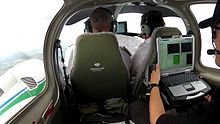
An airborne sensor operator (aerial sensor operator, ASO, Aerial Remote Sensing Data Acquisition Specialist, Aerial Payload Operator, Police Tactical Flight Officer, Tactical Coordinator etc) is the functional profession of gathering information from an airborne platform (Manned or Unmanned) and/or oversee mission management systems for academic, commercial, public safety or military remote sensing purposes. The airborne sensor operator is considered a principal flight crew or aircrew member.
The modern airborne sensor operator profession began in 1858 when Gaspard-Felix Tournachon “Nadar†first took aerial photographs of Paris from a hot air balloon.
The first governmental-organized air photography missions were developed for military surveillance during World Wars I and II but reached a climax during the Cold War. However, the airborne sensor operator profession developed ever so more in all industry sectors during these decades with the advancement of radar, lasers, radio/signal receivers and electro-optical/infra-red technology.